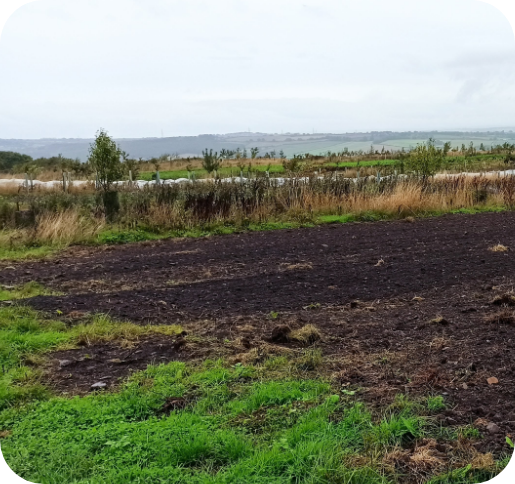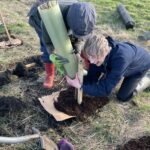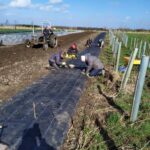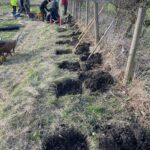LIVING LAB 7: Reino Unido
Granja comunitaria de Gibside
Granja de Agricultura Apoyada por la Comunidad (AAC)
General información
Gibside CSA está situada a 30 minutos de Gateshead/Newcastle upon Tyne, en el norte de Inglaterra. La granja es una sociedad de interés comunitario (CIC) con dos directores y un grupo directivo formado por otras tres personas. Hay unos 20 miembros que acuden regularmente al campo para cultivar los productos con el apoyo de cultivadores contratados durante unas 13 horas a la semana en verano. Gibside Community Farm (GCF) alquila un campo de 5,8 hectáreas (ha) a la Fondo Nacional. Muchos de los miembros tienen experiencia en el cultivo en huertos, pero también es un lugar de apoyo para que la gente venga y aprenda sobre el cultivo ecológico.
El National Trust apoyó la idea de crear una granja comunitaria en sus terrenos y ayudó a los miembros fundadores a crear la CIC en 2013. En 2017, se concedió el arrendamiento de los terrenos y se pudo empezar a instalar la infraestructura. Se firmó un contrato de arrendamiento de 25 años con la finca Gibside National Trust y el largo periodo de arrendamiento permitió a la CSA recibir subvenciones para comprar árboles. La agrosilvicultura formó parte del diseño de Gibside Community Farm desde el principio. La primera subvención que recibieron fue de la 'MOREwoodsiniciativa de la Woodland Trust. Sin embargo, sólo podían suministrar árboles autóctonos y la variedad de especies era limitada. Tras dirigirse a una fundación benéfica local, se consiguieron otras 3.000 libras esterlinas para comprar árboles adecuados para el sistema de silvohorticultura del GCF. El sitio Fondo de Investigación AgroforestalMartin Crawford.
Una de las principales razones para incorporar árboles al CSA fue reducir el impacto del viento en un lugar muy expuesto. También se tuvieron en cuenta los beneficios adicionales de los árboles para la producción de hortalizas y otras relaciones beneficiosas.
A la hora de poner en marcha el campo de la silvohorticultura, los miembros del GCF se fijaron en el sistema de Wakelyns y Tolhurst ecológico con vistas a reproducir elementos de lo que estaban haciendo. También se tuvo en cuenta el asesoramiento de Ian Tolhurst sobre la viabilidad del plan de la finca. La mayoría de los árboles de los callejones son inmaduros, de 5 años. Los cinturones de protección están formados por árboles autóctonos jóvenes, de 7 a 8 años, como nogales, castaños, alisos, abedules, robles y pinos silvestres.
Inicialmente, el CSA operaba desde el jardín amurallado del National Trust, para probar el modelo antes de trasladarse al campo a mayor escala en el que se encuentran actualmente. Antes de que el campo de 5,8 hectáreas se convirtiera a la silvohorticultura, formaba parte de una rotación de cultivos herbáceos.
Los productos hortícolas se venden principalmente a los socios mediante un sistema de bolsas. Incluye lo que está de temporada en la granja y también se vende a través de un sistema en línea. Otras vías de venta son la venta al por mayor de productos ecológicos, un puesto improvisado en el mercado National Trust Gibside y mercados ocasionales. Los rendimientos en 2023 ascendieron a 10,45 toneladas, que incluían 5,5 toneladas de patatas, 1,6 toneladas de alliums, 223 kg de remolachas, 2,22 toneladas de brásicas y 294 kg de legumbres.
Enfoque agrícola general
Ecológico
Objetivos
Como Gibside es una granja de CSA, el objetivo principal es producir verduras orgánicas, de temporada y locales para sus miembros de una manera beneficiosa para el medio ambiente a través de un sistema de bolsas. La implicación de voluntarios permite a la población local participar directamente en la CSA, al tiempo que hace que el proyecto sea económicamente viable.
- El sistema agroforestal de silvohorticultura ayuda a dar cobijo a los bancales de hortalizas, ya que el emplazamiento es alto y expuesto, por lo que a menudo sopla mucho viento. También hay grandes cinturones de protección alrededor del perímetro de la explotación, que contiene varias hileras de árboles autóctonos semimaduros. Las hileras de árboles crean un microclima que favorece la producción de hortalizas. Los árboles de la granja también pueden crear una fuente de ingresos adicional.
- La CSA ha apoyado a la comunidad local mediante el suministro de espigado (excedentes de verduras y frutas) para la Waste Food Kitchen (Café Sombrero Mágico).
Desafíos
- Al principio, conseguir los árboles a través del Woodland Trust fue todo un reto, ya que las variedades disponibles se limitaban a especies autóctonas y no eran adecuadas para un sistema agroforestal. Gibside Community Farm se puso en contacto con una fundación benéfica local que le concedió una subvención para adquirir árboles de un especialista en agrosilvicultura.
- Ajustar la rotación en el campo basándose en lo que habían hecho otras personas y establecer la mejor anchura y longitud de callejón fue todo un reto: se necesitaba una buena longitud de trabajo para la escala de campo.
- El principal problema que intentan resolver en la explotación es cómo reducir al mínimo el laboreo de las hortalizas. Esperan encontrar un método que no requiera equipos caros, y hacerlo a mano no es factible por la cantidad de tiempo que lleva. Por el momento, dependen de las malas hierbas.
- Encontrar suficientes clientes de bolsas de verdura para que el dinero que generan se convierta en la principal fuente de ingresos es un reto constante. Les gustaría encontrar un equilibrio entre la cantidad de producto que se destina a la venta mayorista ecológica y a la venta directa.
- En el pasado se han utilizado semillas F1, lo que ha supuesto una limitación, ya que producen todo al mismo tiempo y esto no se ajusta al modelo de bolsa de verduras semanal. En el futuro, quieren utilizar semillas de polinización abierta en el GCF para que los productos estén disponibles de forma constante durante toda la temporada de crecimiento y se puedan recoger de forma intermitente.
Objetivos de la investigación
La esperanza es integrar más árboles en la granja, ya que todavía hay un problema de viento en un lado de la granja y porque un par de filas de agroforestería no se llevaron a cabo y necesitan ser reemplazados. El GCF está interesado en saber más sobre otras especies de árboles que podrían plantarse en los callejones sobrantes.
La economía del CSA es importante, ya que no podría continuar sin ser viable económicamente. La agrosilvicultura crea potencialmente una fuente adicional de ingresos para la granja y crea un microclima que permite el crecimiento de las hortalizas.
El equipo que dirige el centro espera que el REFOREST Living Lab aborde la cuestión de la reducción del laboreo en un sistema orgánico como éste y el tratamiento de las malas hierbas resultantes. Por el momento no tienen una solución que no sea demasiado cara o lleve mucho tiempo, pero agradecerían las aportaciones de otros agricultores que formen parte del laboratorio viviente.
Diseño del sistema agroforestal
En el campo de 5,8 ha de silvohorticultura hay 7 parcelas de hortalizas con callejones de árboles de 3 m de ancho entre ellas. Cada cama mide 21 m por 100 m. Las parcelas siguen una rotación de 7 cursos: un ciclo de patatas, brásicas y alliums, seguido de una rotación de 4 años con abono verde de larga duración. Las parcelas se diseñaron intencionadamente anchas para minimizar la competencia entre árboles y hortalizas y permitir el uso de maquinaria de campo. Los árboles de los callejones incluyen sauce canasta, avellano, frutales delicados y frutales resistentes. El lado del campo que no tiene callejones de árboles se ha utilizado para cereales y legumbres, pero ahora se utiliza como campo de heno. También hay una zona de huerta con setos entre las parcelas.
Los principales cinturones de protección que protegen toda la explotación contienen varias hileras de árboles autóctonos semimaduros y proporcionarán una protección sustancial contra el viento. Los cinturones de protección atraviesan el suroeste, el oeste y el noroeste del campo de cultivo. También hay un cortavientos al noreste junto a la entrada de la explotación. Al norte de los bancales de silvohorticultura, al noroeste del campo, se encuentra una zona de huertos frutales, con cierta protección de un seto al norte. Actualmente consta de 44 manzanos, en su mayoría medio-árboles sobre portainjertos MM106. Las variedades mixtas de especies de árboles frutales que crecen en el huerto se valoran porque tienen tiempos de cosecha escalonados que garantizan que la fruta esté disponible durante más tiempo.
La explotación utiliza estiércol de caballo procedente de un establo de la zona. Hay un gran politúnel que se riega por aspersión. Un contratista se encarga de cortar una gran superficie de heno para ensilar unos 33 fardos al año.
Supervisión
En el pasado se han recogido datos estándar sobre el suelo en la explotación, y recientemente se han recogido amplios datos sobre el suelo y la productividad de la tierra en el marco del proyecto REFOREST. Esto podría volver a hacerse en el futuro para comprobar si el suelo ha mejorado con el sistema agroforestal.
El lugar cuenta con un pluviómetro, pero actualmente no dispone de estación meteorológica.
Cómo minimizar el laboreo en las parcelas de hortalizas sin utilizar equipos caros es una cuestión clave. Descubrir cómo lo hace la gente haría que participar en el Living Lab del Reino Unido mereciera la pena.
 Cargando...
Cargando...

Inglaterra, Reino Unido

Fellside Rd, Burnopfield, Newcastle upon Tyne, NE16 5LA

Silvohorticultura, huertos, setos, cinturones de protección y franjas de protección ribereñas

Una gama de hortalizas que incluye alliums, brassicas y patatas

El campo está alquilado al National Trust y el arrendamiento oficial se concedió en 2017. La plantación de árboles comenzó en el invierno de 2016 en el huerto, y en el invierno de 2017 en los árboles del callejón y los cinturones de protección.

Distancia entre hileras: 21 m x 100 m

Anchura de las franjas de árboles callejones de 3 m - cinturón de protección de 5 m

5,8 ha de campo cultivado
1,47 ha de hortalizas
0,2 ha de árboles de callejón

Horticultura

Ganado: No










